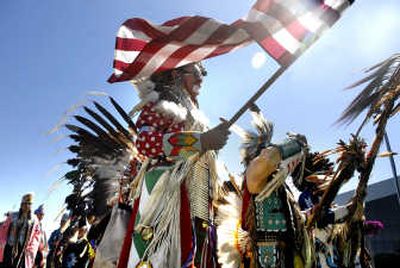Indians celebrate culture at powwow

Eleven-year-old Natasha Cox fidgeted as her mother wrapped her braids in red ribbon. It was almost time for her to join the other dancers at the first dance of the day.
She wore a shiny gold shirt with a red sequined cape that went over her head and sat like a vest, and a full gold skirt covered with colorful swirl patterns. Beaded discs and feathers were securely fastened to her hair. Bright ribbons trailed at the end of her shawl. When she danced, green, orange, purple and blue would swirl around her.
Natasha gathered her skirt and shawl in her hands and walked the grassy hillside of the Lilac Bowl at Riverfront Park, joining hundreds of other dancers in the arena at the weekend’s 18th annual Spokane Falls Northwest Indian Encampment and Pow Wow.
The event, which draws thousands of Native Americans from tribes including the Spokane, Colville, Kootenai, Coeur d’Alene and Kalispel, is a traditional gathering that allows tribes to celebrate their culture as well as share it with others, said Sonny Quinto, 28, one of the arena directors and an organizer for the event. He has been going to the event since he was 9.
“It’s not like any event held in the park, or even in the entire city. It’s unique,” he said. “We get to come here and share a little bit of our culture.”
The powwow consists of four sessions, and each one starts with a grand entry – a procession of all the dancers. The competition divides dancers into categories based on age groups. Natasha, who has been dancing since she was 5, is in the juniors category and practices a style of dance called fancy dance.
“It gets very hot,” she says, smiling about her regalia. The number 417 was pinned to her cape.
Natasha is serious when it comes to dancing. Quiet and a little stern, she explains the rules of the dance competition. She is judged on footwork and her outfit. Nothing can fall off the outfit, or she’ll be disqualified. Feathers are not supposed to touch the ground. She gets extra points for being at the grand entry.
“Spokane is a hard one,” said Natasha, who recently placed second at a Daybreak Star powwow in Seattle. “Sometimes it’s about popularity and knowing people, and there are just so many girls here in that category.”
She enjoys dancing and wants to do it a long time.
“As you get older and get more serious, you have to buy a lot more things because they give you a lot more points,” she said.
Outfits like Natasha’s can cost thousands of dollars, said her mother, Carla Harding. Basic regalia consisting of a cape, shawl, leggings and sometimes a skirt can start at $500.
“The more parts, the more expensive it gets,” Harding said as she pinned the skirt of Natasha’s sister Milla, 5. Milla was wearing Mickey Mouse-themed regalia that was black with colored ribbon on the shawl. Natasha’s other sister, Peja, 3, wore one of Natasha’s old jingle dresses. The dress gets its name from the dozens of cone-shaped bells attached to it. Natasha is glad to be able to keep all of her old regalia.
“I still have my first moccasins,” she said.
Because she loves to dance and compete, Natasha has been to more powwows than the rest of her sisters. She often goes with her grandparents, Chuck and Bobby Cox, one of the 30 vendors at the event. The Coxes are regular vendors at powwows and have attended the Spokane Falls Northwest Indian Encampment and Pow Wow for 17 years. They sell a variety of wares, including caps, scarves, jewelry, and – their best sellers – Native American music CDs. Chuck Cox said powwows are an important part of educating others about Native American culture.
“The powwow’s purpose is to open it up and let the non-Indians see what we are really all about,” he said. Cox, 68, has been to eight powwows this year, but he used to go to more.
“Too old to travel now,” he jokes. Next weekend they’ll be at another powwow in Wellpinit on the Spokane Indian reservation.
“We do this because we enjoy it,” he said. “If you can’t go to a powwow and have fun, something is wrong with you.”
Quinto agrees that powwows are good for educating others.
A member of the Colville Confederated Tribes, he adds that there are many layers to the history and significance of powwows that cannot be easily explained.
“The dresses are beautiful, and the drumming is beautiful – it goes deeper than that,” he said. A Spokane resident for 10 years, he emphasizes the importance of keeping connected to his culture.
“I went to school out here, I work out here, raised my family here. Spokane is my home,” he said. “But I maintain my ties back home with my family. … All Indians in the city have ties back home.”
He sees this gathering of people as a huge statement for how Native Americans are thriving in the urban environment.
“As American Indian people, we pretty much forged ourselves through the 21st century,” he said, watching a young child laughing and dancing to music. “It’s now more important than ever to remember our ability to survive, adapt and succeed in a world of change.”
The powwow continues through today with the grand entry at 1 p.m.